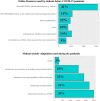Online medical education in Egypt during the COVID-19 pandemic: a nationwide assessment of medical students' usage and perceptions
- PMID: 35354406
- PMCID: PMC8966850
- DOI: 10.1186/s12909-022-03249-2
Online medical education in Egypt during the COVID-19 pandemic: a nationwide assessment of medical students' usage and perceptions
Abstract
Background: The coronavirus (COVID-19) pandemic required a transformation of medical education in Egypt. Public health measures necessitated a rapid shift from traditional face to face lectures to largely online platforms following campus closures. The aim of this study is to characterize medical student use and perception of online medical education in Egypt as well as exploring the efficacy of different e-learning modalities. Additionally, many barriers and opportunities as perceived by students are reviewed to inform future educational improvements.
Methods: A 29-item online survey was created on google forms and distributed by social media to medical students across 26 Egyptian medical schools. The survey was administered from August 20th, 2021, to September 5th, 2021. The survey consisted of a mixture of questions style. The medical students were asked about their experiences with online medical education during the COVID-19 pandemic as well as medical students' anxiety, perceived academic performance, and obstacles related to online education.
Results: Of the 4935 responses collected, 43.4% (n = 2140) of respondents were women; 56.6% (n = 2795) were men. Medical students from private medical schools were 13.0% (n = 644), whereas 87.0% (n = 4291) were from public medical schools. 54.6% of students reported that online education is not as effective as face-to-face education. There was a significant rise in hours spent by medical students on online medical education compared to before COVID-19 pandemic. More than half of students (63%) agreed that online recorded video tutorials (e.g., YouTube) were the most effective form of online medical education.
Conclusion: The shift to online education has significantly impacted medical students in Egypt. Medical students reported various limitations and challenges of online medical education, which must be addressed considering the potential benefits of online platforms over traditional face to face learning. The results of this nationwide study provide a framework for potential areas to implement change to improve the accessibility and structure of online medical education in Egypt.
Keywords: COVID-19; Egypt; Medical education; Medical schools; Medical students; Online medical education.
© 2022. The Author(s).
Conflict of interest statement
The authors declare that they have no competing interests.
Figures






References
-
- Years Don’t Wait for Them: Increased inequalities in children’s right to education due to the COVID-19 pandemic. Human Rights Watch May 17, 2021. Available from https://www.hrw.org/report/2021/05/17/years-dont-wait-them/increased-ine.... Cited 9 Sept 2021.
Publication types
MeSH terms
LinkOut - more resources
Full Text Sources
Medical

